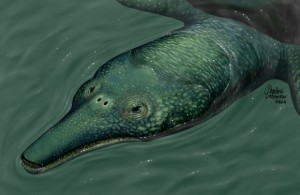 The newly discovered turtle, namedOcepechelon bouyai, is one of the biggest marine turtles that ever lived on Earth, according to a study published in the open-access journalPLoS ONE.
The newly discovered turtle, namedOcepechelon bouyai, is one of the biggest marine turtles that ever lived on Earth, according to a study published in the open-access journalPLoS ONE.
The generic name Ocepechelonderives from an acronym for the Groupe Office Chérifien des Phosphates, the mining company exploiting phosphatic deposits in Morocco, and from the Greek wordchelone (turtle).
The specific name honors Baâdi Bouya, engineer geologist and head of the OCP Geological Survey in Khouribga, for his help during fieldworks.
Ocepechelon is known from an almost complete 28-inch-long (70 cm) skull found in Sidi Chennane area in Morocco’s Khouribga Province.
Its striking anatomy suggests the turtle was adapted for suction feeding, never seen in known turtles.
“The feeding apparatus ofOcepechelon, a bony pipette-like snout, is unique among tetrapods,” the authors wrote in the paper.
 Skull of Ocepechelon bouyai (Bardet N et al)
Skull of Ocepechelon bouyai (Bardet N et al)
Ocepechelon shares interesting resemblances with beaked whales. “Ocepechelon and most beaked whales are large animals, and, as in all other extant cetaceans andOcepechelon, the nostrils of beaked whales are posterodorsally shifted. They also share similarities on their feeding apparatus: elongated jaws and a small gape.”
“The mouth gape of Ocepechelon can be inferred from the diameter of the tube – about 2.5 inches (6 cm). It is worth emphasizing the disproportion between the tiny size of the mouth opening and the large size of theOcepechelon’s skull.”
The snout diameter shows thatOcepechelon was a small-prey hunter and may have fed on small fishes, cephalopods and jellyfishes.
“In pipefishes the snout length is inversely related to the mouth cross-section and is considered as an evolutionary advantage since it reduces the time to reach the prey. InOcepechelon, the elongated rostrum and the round and small mouth much likely increased the velocity of the water influx,” the scientists explained.
Bibliographic information: Bardet N et al. 2013. A Giant Chelonioid Turtle from the Late Cretaceous of Morocco with a Suction Feeding Apparatus Unique among Tetrapods. PLoS ONE8 (7): e63586; doi: 10.1371/journal.pone.0063586







